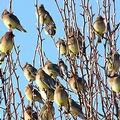 北美科學家發現,鳥類族群的多樣性有助於緩衝人類感染病毒的可能性。自從西尼羅病毒(West Nile Virus,WNV)首次在北美爆發案例,迄今已經達到對人類造成危害的傳染病程度,且據報超過1,100人死亡。
北美科學家發現,鳥類族群的多樣性有助於緩衝人類感染病毒的可能性。自從西尼羅病毒(West Nile Virus,WNV)首次在北美爆發案例,迄今已經達到對人類造成危害的傳染病程度,且據報超過1,100人死亡。
國際鳥盟之研究與指標協調員布查特博士(Stuart Butchart)11日於劍橋在一場WNV病毒研討會前夕指出:「對生物多樣性與人類健康的相關連而言,這是個重要的案例。」WNV研討會在2月15日於喬治亞州舉行。
這項研究初由威廉與瑪麗大學生物學家史瓦都(John Swaddle),以及大學部學生卡洛斯(Stavros Calos)發現,鳥類族群多樣度較高的區域,其WNV病毒在人類身上發生案例較少。
作者特別指出,「有越來越多的證據指出,生物多樣性具有生態系統功能上重要的經濟價值。」WNV主要感染對象為鳥類,但可藉由蚊子傳播人類。1999年美國即發現,WNV在鳥類、人類、獸醫、與蚊子之間的活動關係。美國各州除了夏威夷、阿拉斯加、奧瑞岡州之外,都有案例出現。自此,WNV已造成超過28,000人感染、超過1,100人死亡的現象;儼然達到流行傳染病的程度。
「我們目前仍不清楚這項關連模式的機制,但很可能是由於,對病毒來說,在多樣性較高的區域,具備特殊條件的宿主與基因庫性質的鳥類物種數量較少。」威廉與瑪麗大學環境科學與政策課程的史威都助理教授如此表示。他接著解釋,宿主特質( Host competence )指的是最容易讓特定鳥類感染疾病並傳遞給載體的一系列特質。具高危險的宿主特質曾發現在烏鴉(crows)、棕鴨(jays)、鶇(thrushes)、麻雀(sparrows)身上。而這些鳥類物種,常常是當整體鳥類物種多樣性減少之餘,最可能存活的鳥種。
超過300種鳥類具有宿主特徵,布查特說,旅鶇( Turdus migratorius, 俗名美國知更鳥)是鶇科中會遷徙的鳴禽,卻被指出是傳播病毒到人類身上的主要宿主。 他表示:「WNV可能加重如棲地流失等鳥類現有的生存壓力,而增加物種滅絕危機。例如,目前只生存在加州的黃嘴喜鵲(Pica nuttalli),在最近兩年受到此疾病影響,已減少將近一半的數量。」
科學家研究這種病毒在密西西比河東岸的美國小鎮中,其鳥類物種多樣性與人類案例數的關連。他們發現鳥類多樣性較高的區域,人類感染病毒的案例較少。研究報告也同時指出一半以上的案例與當地鳥類族群差異有關。
這項研究報告也假設,即使傳染病正流行,較高的鳥類族群變異度能夠降低人類感染案例數。
物種多樣性與疾病比例的連結方式已被綜合在稀釋效應中,因此確切的機制並不明確。科學家相信,若生態系統中生物多樣性的增加,會減少或稀釋一個疾病的可能宿主比例,並因此減少傳染機率。
稀釋效應最早從萊姆病的研究中被提出;但這項新研究中假設,稀釋效應可以被廣泛應用。果真如此,這可能成為公共衛生與安全計畫中的重要工具。
史瓦都說:「研究指出,非常小的土地經營變化可以吸引更多鳥類物種前來,因為生物多樣性的增加會提供回報,當類似WNV、禽流感、或是淋巴腺鼠疫等鳥類人類共通疾病發生時,人類感染機率會減少。」
「生物多樣性正提供我們公共衛生上的服務,而人們很少考慮到這種現象。」他繼續說:「當未來面臨開發土地與管理鳥類族群的議題上,這項服務則應該被考量在內。」
這篇名為:「增加鳥類多樣性與減少人類西尼羅河病毒的感染:稀釋效應的觀察」 於2008年6月刊登在公開索取的線上期刊『 PLoS ONE* 』之中。
*注:PLoS ONE 為公共科學圖書館(Public Library of Science)所發佈的國際、線上、公開、可共同修正(peer-review)且非收益性質的期刊。本篇提到的期刊論文,可點選此連結。
North American scientists studying West Nile virus have shown that more diverse bird populations can help to buffer people against infection. Since the virus first spread to North America it has reached epidemic proportions and claimed over 1,100 human lives.
"This is an important example of the links between biodiversity and human health," observed Dr. Stuart Butchart, global research and indicators coordinator for BirdLife International, speaking Wednesday in Cambridge on the eve of a West Nile Virus conference today in Savannah, Georgia.
The study, by biologist John Swaddle and then undergraduate student, Stavros Calos '08, at William and Mary University, found that areas which have a more diverse bird populations show much lower incidences of West Nile virus infection in the human population.
The authors highlighted the "increasing evidence for economically valuable ecosystem services provided by biodiversity."
West Nile virus mainly affects birds but can be transferred to humans via mosquitoes. Found in the United States since 1999, WNV human, bird, veterinary or mosquito activity have been reported from all states except Hawaii, Alaska, and Oregon. Since first introduced, the virus has reached an epidemic scale with over 28,000 human cases resulting in more than 1,100 deaths.
"We don't yet know the precise mechanism that drives this pattern, but it's likely to be due to diverse areas having relatively few of the bird species that are particularly competent hosts and reservoirs for the virus," said Swaddle, an associate professor of biology and director of the Environmental Science and Policy Program at William and Mary.
Host competence, he explains, refers to a set of qualities that make a particular species of bird best able to contract the disease and pass it on through a vector. The highest levels of host competence are found in crows, jays, thrushes and sparrows, the very birds that tend to thrive when avian biodiversity is reduced.
Over 300 species act as hosts, although Butchart says the American robin, Turdus migratorius, a migratory songbird of the thrush family, has been named as largely responsible for transmission from birds to humans.
"West Nile virus may compound existing pressures - like habitat loss - to increase the risk of extinction for species," he said.
For example, the yellow-billed magpie, Pica nuttalli, which is found only in California, appears to have declined by almost 50 percent in the last two years as a consequence of the disease, Butchart said.
Scientists studying the virus looked at U.S. counties east of the Mississippi River and compared their avian diversity with the number of human cases. They found that high bird diversity was linked with low incidence of the virus in humans. They reported that about half of the human incidences of West Nile virus could be explained by the differences in local bird populations.
The findings also suggest that diverse bird communities lowered human case numbers even when the epidemic was underway.
The way in which biodiversity and disease rates are linked has been dubbed the dilution effect. Although the exact mechanisms are not currently clear, scientists believe that increased diversity within an ecosystem reduces, or dilutes, the proportion of suitable hosts for a disease, and therefore reduces transmission rates
The dilution effect has previously been studied through another infection, Lyme disease, but this new research suggests that it may be more widely applicable. If so, it could be a valuable tool for public health and safety plans.
Swaddle said the research indicates that very small changes in land management could attract more bird species, with the increase in biodiversity paying off in the form of lower human infection rates during outbreaks of West Nile or other diseases in the bird population, such as avian flu and bubonic plague, that can be transmitted to humans.
"Biodiversity is giving us a public health service that people have rarely considered," he said, "and the value of this service should be considered when developing land and managing bird populations in the future."
Entitled "Increased avian diversity is associated with lower incidence of human West Nile Infection: observation of the dilution effect," the paper was published in June 2008 in the peer-reviewed open access journal "PLoS ONE."







